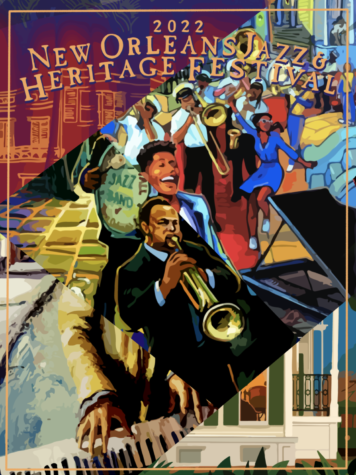OPINION | Return of Jazz Fest brings community, culture

The “World’s Greatest Backyard Barbeque” is returning to the Fair Grounds Race Course for the first time since 2019, bringing with it the culture of New Orleans.
The New Orleans Jazz & Heritage Fest, the annual music and cultural festival, is known by various names: The World’s Greatest Backyard Barbeque, America’s Greatest Festival and Louisiana Heritage Festival are among them. No matter the name, the themes of cultural relevance and community prevail.
Jazz Fest is an annual festival in New Orleans that dates back to 1970 when Mahalia Jackson, a local New Orleanian known as the “Queen of Gospel Music,” united with Duke Ellington and the Eureka Brass Band at New Orleans’ first Jazz Fest.
The trio played alongside local New Orleans artists in Congo Square, a square that is arguably the birthplace of music and culture in New Orleans.
Since then, the festival has relocated to the Fair Grounds Race Course, an area that can accommodate the festival’s ever-growing crowd.
In 2005, Hurricane Katrina devastated New Orleans. The category 3 hurricane demolished the city, flooding 70% of New Orleans and causing $125 billion in damage. As the city slipped into its darkest hours, Jazz Fest appeared completely out of question.
Seemingly by the grace of god, on April 28, 2006 — a mere eight months later — Jazz Fest opened its gates. After months of isolation, closures and reconstruction, Jazz Fest offered a watering hole for the community to reconnect.
Jazz Fest reflected the resilience of the community and served as a neutral ground for those near and far to connect through their shared trauma post-Katrina.
However, in 2020, the unthinkable happened: the headline hit that Jazz Fest was canceled. As COVID-19 quickly gained pandemic status, Jazz Fest was forced to close its gates, promising a quick return the following year.
In 2021, matters only got worse. Every day brought about new daily records for COVID-19 cases in the city. The cancellation of Mardi Gras parades that were set to take place just two months before Jazz Fest removed any glimmer of hope for a normal spring in New Orleans.
Just shy of a year after the cancellation of the 2020 Jazz Fest, déja vu swept across New Orleans. It was announced that Jazz Fest would once again not be happening that spring. However, Jazz Fest was postponed, not canceled. Hope returned to New Orleans as an air of normalcy was promised in the near future.
This hope, while mighty in nature, was short lived. As August rolled around, so did the news that Jazz Fest would be canceled once more, citing surging COVID-19 rates as the reason.
The third time may be the charm, but for New Orleans, the third time hammered desperation and isolation into the atmosphere. Jazz Fest seemed like a distant memory.
Three FDA-approved vaccines, countless improvements in testing and tracing measures and a weakened COVID-19 strain later, Jazz Fest will be returning to the Fair Grounds Race Course for spring of 2022. The festival, in classic New Orleans fashion, was resilient and fought its way back to the stages.
Beyond being a force that united the community, Jazz Fest rakes in money for the city, bringing in more than $300 million. The 10-day cultural celebration draws in 400,000 visitors annually, bringing customers to locally-owned small businesses that the Bourbon Street crowds may overlook.
Two years of cancellations not only served a big blow to the spirit of the community, but to the pockets of the community as well.
New Orleans is a “melting pot” of a city. The city’s deep cultural and historical roots have drawn in people of all different races and cultures since its founding. It is a city where many come, but few may ever want to leave.
The diverse background of New Orleans is not what makes it so special. It is the ability of this diverse population to come together and constantly work as one to better the community. The impact of Jazz Fest goes beyond the gates of the Fair Grounds; the impact of Jazz Fest is seen through the connectivity and synergy that radiates within the community.
Your donation will support the student journalists of Tulane University. Your contribution will allow us to purchase equipment and cover our annual website hosting costs.


